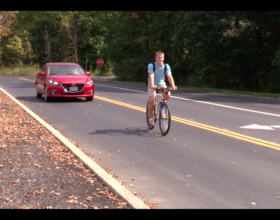Zak D. (Staff)
A 10,000-acre conservation center, The Wilds is an oasis of endangered and protected wildlife ranging from China’s Pére David’s Deer to Kenya’s Masai Giraffe. With 25 different species and 500+ animals, with herbivores roaming freely throughout the park, The Wilds existence seems impossible in Cumberland, a small town in southeast Ohio, that Dr. Kurth and Mrs. Eisert’s Environmental Science classes visited on an October 9th field trip.
At the Wilds, twenty environmental science students went on a 3-hour safari through the vast plains which encircle the large lakes and patches of forest, regularly stopping to take pictures of the exotic wildlife. Students got especially close to a curious Persian Onager, a donkey-like species native to the desert regions of Iran, who came within an arm’s length away, and a 2.5 ton Indian Rhino, which was near enough to see the deep wrinkles that stretched across its massive body.
After the safari, we explored the mid-sized Carnivore Center, a section that enclosed cheetahs from Africa and Southeast Asia’s Dholes. But their crown jewels are the African painted dogs, known for their coats of fur, which look as if black, white and brown paint were splattered onto their bodies. The Wilds conservation of these canines is critical in the ongoing process of moving them away from the brink of extinction—brought there by habitat loss and fragmentation, which exacerbated rabies and distemper epidemics within populations. Increased exposure to human settlements’ unvaccinated domesticated dogs–due to shrinking territories–is a driving force in exposure to these diseases. A fan favorite, many of us noted how interesting the dogs’ fur was—including Owen L., who seemed especially captivated, saying, “It was almost a surreal experience to see them up close. I’ve always been interested in their fur—they’re like a living and breathing canvas filled with splotches of brown, black and white. I know that they’re considered a very endangered species, so it felt weird to be seeing them in Ohio of all places.”
A paragon of Midwestern environmental science, The Wilds is in the vanguard of North-American conservation science. Student feedback was fantastic for the trip—most mentioned that it allowed them to experience first-hand what they’re learning about. As Nolan M. said, “The trip was a really great learning opportunity, and it gave us an up-close view of the topics we’re learning about in action, instead of just learning about them in textbooks or videos. It put the things we’ve been learning about into perspective. Overall it was a really cool experience.”
Through The Wilds, students have the chance to attach concepts to memory, which gives them a huge advantage in their studies. Additionally, it shows them why topics they’re studying matter, establishing a personal connection with Environmental Science. The park serves as a reminder that the effort to save endangered and vulnerable species isn’t just conducted in faraway countries, but right here in the heart of the Midwest. So next time you’re thinking that Ohio is boring or that there’s nothing to do here, remember that the world’s largest safari and conservation park is only 90 minutes away.
According to its website, from the 1940’s to 1971, the land The Wilds lies on was used for coal-mining. This destructive process continued up until the Federal Reclamation Act of 1971. This act required that the coal-mining cease and replace the topsoil that was removed in order to allow for the coal-mining. Topsoil’s nutritious organic matter is what allows an environment to support an ecosystem, fostering plant and microbial species that are necessary for a community to function. After the restoration process of the land, the park officially opened to the public in 1994.









